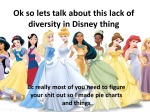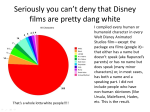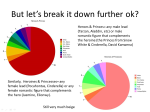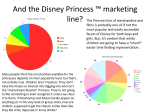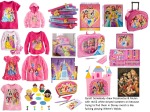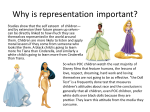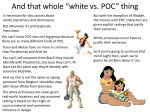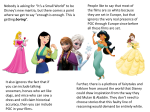“you are asking for an unrealistic amount to representation” honey the only thing unrealistic here is your all white cast
racism
Offensive Mistakes Well-Intentioned Writers Make
Food-Colored Skin
Not only is purple prose obnoxious; sometimes it’s downright racist. For some reason, writers have a fondness for describing dark complexions as “chocolate” or somesuch.
But wait, people like chocolate! What’s so bad about likening a skintone to something almost everyone likes?
The problem is that food-colored skin is a phenomenon mostly limited to dark-colored complexions. And it’s more than just a little creepy when strangers keep likening your skintone to an inanimate edible object. Plus, in some places “chocolate bar” is a playground taunt used to goad black children.
Not a very tasteful choice in similitudes at all.
Skin Color Only Described When Not White
In many stories, the color of a character’s skin will only be described when the character doesn’t have a fair complexion. This typically happens because the writer is white and subconsciously thinks of xir own skin color as the default and everyone else’s as the outliers. Even JK Rowling, whose books frequently focus on tolerance and equality, is guilty of this.
The solution is simple – just describe everyone’s complexion, and all will be well.
Written Accents
Written accents are offensive because they essentially tell the group whose accent is being written that “your way of talking is weird; my way is normal.”
Not only are written accents offensive to the group being represented, but they’re offensive to read because you have to spend extra time trying to sort out what the writer was trying to say.
If you want to write a character who is supposed to have an accent, use grammar and slang associated with people who have that accent. You could also just mention that they have an accent. But don’t butcher the spellings of the words. “He’s got himself in a right pickle, he has” is fine, but “‘E’s got ‘imself in a right pickle, ‘e ‘as” is not.
Things Appropriated From Other Cultures
Many new writers are bound and determined to make sure their characters have meaningful and unique names. I see many people who have clearly scoured the bowels of online baby name sites to find the perfect Vedic/Japanese/Aztec name for their white character.
This sort of thing is a form of cultural appropriation, which is a pretty huge faux pas. For the uninformed, cultural appropriation is when a member of a dominant culture takes something from an oppressed/minority culture and uses it in a shallow, trendy, or superficial way – and there’s really nothing more shallow or superficial than trying to make your character stand out by giving xir an “exotic” name instead of giving xir a memorable personality and story.
Likewise, people give their characters katanas and throw youkai into their stories for no other reason than “it’s more interesting” than Western culture. Throwing things from another culture into your story for no other reason than you think it’s “more interesting” reduces that culture to a cheap gimmick, which is pretty rude and offensive.
“Harmless” Stereotypes
The Japanese plant-lover. The wise Native American. The sexy Latina. There’s nothing bad about loving plants or being wise or sexy, so why would anyone find these offensive?
For one thing, it can create unrealistic expectations and assumptions about these people. Many Asian-Americans find themselves having to explain to people that no, they don’t know squat about gardening, really. Many Latinas would rather people didn’t expect them to be hot and spicy lovers based on their race. And contrary to what some think, Native Americans aren’t really born with a magical connection to the Earth and tend to find assumptions that they are quite irritating.
The Supercrip
There are two varieties of supercrips: the first is a disabled person who is treated as a hero just for doing everyday things that most people take for granted. It’s quite frankly condescending, and many disabled people would thank you to knock it off.
The second type is the character who has amazing skills or abilities because or in spite of xir disability. While a writer might be trying to say “just because a person has a disability, doesn’t mean they can’t be amazing!”, what the audience hears is “disabled people often have amazing abilities to make up for their disability,” which unfortunately isn’t true.
The Mighty Whitey
The Mighty Whitey is a white person (if not physically, then culturally) who finds xirself faced with the task of saving a marginalized group (often as not from other white people). The character is usually male and ends up becoming the leader of the people he just liberated, and he usually ends up with a hot ethnic-looking gal to boink. (Think Jake Sulley fromAvatar, and you’ve got the Mighty Whitey in a nutshell.) The Mighty Whitey will learn the ways of an ethnic group, and xe will become even better at them than the people who have been studying them all their lives.
What makes this trope so horrendous is the attitude of white supremacy: it implies that non-white people cannot solve their problems without a white person to help or even lead them, and that white people will always be better at everything.
Also, becoming a leader of a people whose culture you have only known/studied for a few months – or even a few years – is one of the most ridiculously puerile fantasies in existence.
Getting Mental Illnesses & Different Neurologies Wrong
Want to create a chilling plot twist? Just the killer the hero’s evil alternate personality! That’s called schizophrenia… right?
Wrong. And this type of thing is incredibly insensitive and offensive.
Aside from the fact that schizophrenia does not create multiple personalities, most people with schizophrenia and multiple personalities are quite harmless. Yet thanks to their portrayal in fiction, many people expect them to be dangerous, which makes their already-difficult lives even more difficult.
Occasionally, some people go the other direction and portray these people as innocent or even mystical. That’s positive discrimination, and that’s also bad because it creates unrealistic expectations.
Whether it’s schizophrenia, multiple personlities, autism, Asperger’s, psychopathy, sociopathy, or anything else, you’re going to use a mental disorder or alternate neurology of any kind, make sure you research it. And whatever you do,NEVER give your character a mental illness just to make xir more “interesting,” because that’s ableism.
Trying to Create an Aesop About Discrimination Without Actually Understanding the Discrimination in Question
Most people think they have a pretty good bead on what racism is all about – it’s about segregation, ugly slurs, and pointy white hats. Same goes with sexism – women can get jobs and vote now, so it must be over, right? Ha, if only.
In real life, these people are very rarely overt – in fact, most racism is extremely subtle, so subtle that the offender doesn’t even realize that what they’ve said or done is offensive or hurtful and will vehemently deny the possiblity that what they said or did could have been offensive. (A common response from these people is “I can’t be an X-ist! I have X friends!” Yeah, if only.)
Some examples of subtle discrimination:
- Telling rowdy children to “stop running around like a bunch of wild Indians!”
- Describing a non-white character or person as “exotic.”
- Dressing up in Halloween costumes depicting ethnic stereotypes.
- Insisting that a woman who does not want children right now will “change her mind” in the future.
- Asking a woman why she’s still single if she’s so attractive.
- Asing a woman who is angry about something if she’s on her period.
- Insulting males who don’t live up to expectations of perceived masculinity by accusing them of acting “girly” or calling them gay.
If you want to learn more about what real discrimination of all kinds look and feel like, I recommend readingMicroaggressions. (Language warning.) Also, check out this handy-dandy list of links to privilege checklists so you can check your own privilege before writing off into the sunset.
Trying to Satirize a Thing Without Understanding Why it’s a Thing
The film Death Becomes Her satirizes the perceived vanity of performers who spend mind-blowing amounts of money on beauty products and plastic surgeries to stay young. Funny film? Yes. But it’s rather sexist in that it treats this perceived vanity as something that just happens to some women for no real reason. It ignores the fact that we live in a society obsessed with youth and that our consumerist culture has commodified it and tries to make us feel inferior every day for not buying it from them. It ignores the fact that the men in control of the entertainment industry constantly pressure women into getting plastic surgery and enhancements, even flat-out refusing to hire women who don’t meet their exact standards of beauty, regardless of their talent.
Killing Off LGBT Characters to Make an Allegedly Non-Hateful Point
There’s this thing that some writers do – they introduce an LGBT character, try to build some some sympathy for xir, and before you know it they’ve killed off this character in a manner that’s reminiscent of that old and noxious “too good for this sinful Earth” trope that pervaded Puritan literature.
This sends an absolutely terrible message to LGBT people – that the only way they can escape the shame and the hate that so often comes with being LGBT is if they die. LGBT youth are at a higher risk of committing suicide already – clearly, this is not a message we want to be sending.
Forgetting Women of Color in Female-Oriented Entertainment
Buffy the Vampire Slayer. Charmed. Pan Am. Sex in the City. All of these female-aimed shows exhibit distinctly monochrome casting choices. Sure, Charmed was sort of justified in that the three leads were supposed to be sisters. But Pan Am has no excuse – and there were plenty of non-white stewardesses in the 60’s.
Multi-Racial Groups Always With a White at the Helm
This wouldn’t be a problem if it didn’t keep happening all the time. But invariably, whenever there’s a multi-racial group or team of some kind, the leader will invariably be white. The implication is that while non-whites are good enough to have on a team, they still aren’t leadership material.
The Fairytale Gypsy
You know the character type – they live in wagons, wear colorful clothing, read fortunes, and play a mean fiddle.
The trouble is, what you see in fiction is a romanticized version of a very ugly reality: “Gypsy” is actually a racial slur for the Roma and Dom people. The reason they’re nomads is because racists have a habit of routing them out whenever they try to settle down, and their eclectic fashion comes from having to wear whatever they can get. Also, they’re no more magical than you or me.
Their portrayal in many fantasies perpetuates the myth that these people are fairytale creatures who vanished along with Long Ago And Far Away, rather than real people who suffer systemic oppression today.
So I made this thing and I’m pretty proud of it, haha.
This is one of the nicest, most hand-holdingest powerpoints I’ve seen here. Thank you for making this so easy to understand.

devmonster: jasmined: With Halloween on the horizon, here is Angie Jordan with an important message. Yes, I’m re-blogging myself. YUS.
YOUR DEPICTIONS AREN’T WRONG… BUT SOMETHING ISN’T RIGHT.
Go take a look at THIS POST. It’s got charts and awesome commentary. I won’t rehash what is already being
saidshouted out from tall buildings. I could go on about this all day. But as someone benefiting from this privilege it isn’t my place. It has already been said by much better people than me.Go learn and try to fucking listen while you’re at it. Don’t allow that knee-jerk “BUT IM NOT RACIST OEH NOES” reaction to prevent you from learning how this actually hurts people. Real living people. Not hooded figures…
On “Kawaii” and Appropriation
I am Japanese and I find the usage of the word “kawaii” by non-Japanese people to be extremely appropriative and damaging. I’ll tell you why:
- It is not just a word for cute. When non-Japanese people say something is “kawaii,” they are not simply saying something is cute. There are hella connotations and implications that come with the word. Which brings me to…
- The subtleties of Japanese pop culture, style, street fashion, etc. get completely lost on non-Japanese people. “Kawaii,” the way non-Japanese people use it, is like a 2-d projection of a very complex and multi-faceted subculture. The subversiveness and subtleties of things like Lolita and Harajuku culture are completely erased when taken out of context and away from actual Japanese people.
- “Kawaii” as an aesthetic contributes to the commodification and exotification of Japanese people. Japanese pop culture and style is not for your consumption. It is not for you to steal and make money off of. It is not for you to exploit. There is a very thin line between “appreciating” things from other cultures and appropriation. You are allowed to engage in Japanese pop culture, but chances are that your desire to consume it is rooted in some really deep exotification, which also ties into…
- Japanese people are not your prop or your costume, we are not here to be cute for you. “Kawaii” and its implications contribute to stereotypes about Asian people. We are not cute, quiet, submissive playthings for your enjoyment. The stereotype that all asian people are just docile is really damaging. I am not your asian bitch. I may be cute, but it’s not for you. We are radicals, we are angry, we fight. That shit isn’t “kawaii.”
- We are so much more than what you take from us.We aren’t just peace-sign loving girls in pigtails and school-girl outfits. We have an entire fucking culture and language that is incredibly rich and beautiful. “Kawaii” as a style just serves to make a caricature out of an entire culture and people.
So basically, if you’re not Japanese, don’t say “kawaii.” Just call it fucking cute. That way your words won’t carry racist implications and I won’t think you’re an asshole.
**This is just what I feel about the matter. My voice should not and does not represent all Japanese people. However, my voice calling this out should be enough for people to stop doing this. It is offensive. It is disrespectful. It is hurtful.
All of this. All. Of. This.
I’mma need
The History channel NOT to call indigenous peoples “primitive” simply because they don’t want none of your White Western technologies an’ shit.
They always edit out the fact that like 80-90% of those “primitive” people have cell phones and other technologies that are just damn convenient, and integrate them seamlessly into traditional life.
The Maasai, traditional pastoral and nomadic folk use cell phones to coordinate business and everyday life as well as call doctors, and gain access to apps for weather and grazing information. (article has video)
And just text each other and bullshit.
Also, traditional Cambodian folks
Traditional Mongolian folks (dressed for Naadam in the photo)
And traditional Inuit living in arctic Canada generally use the internet to connect and also pass on those traditions to the next generation…
So yeah a ton of those documentary-anthropology shows are editing out things that don’t fit their idea of “primitive” and then ramble on and on about how “primitive” the people they’re following around with cameras are.
It’s total bullshit.
“In places like Bali, native villages have resorted to ‘staged authenticity’ (hiding televisions and swapping T-shirts for traditional ‘ethnic’ outfits when tour buses show up) to maintain a tourism-dependent economy. Granted, Balinese villagers are just as Balinese when dressed in blue jeans, but that simply doesn’t jibe with the fickle market demands of ethno-tourism. Consequently, we end up with these surreal scenarios, wherein tourists from Los Angeles will travel to Thailand to see modern Hmong peoples, yet those same tourists would never think to visit a community of similarly modern Hmong people in Los Angeles… many ethno-tourists aren’t traveling the world to interact with people—they’re traveling the world to interact with clothing.” —Rolf Potts
#LOL WHITE PEOPLE
“i like white cecil because that makes cecil/carlos an interracial couple!”
you are literally saying that the entirety of people of color, all of them, EVERYONE WHO IS NOT WHITE, whether nigerian or indian or native american or japanese or roma, they are exactly the same and it’s only white people that are ~different~ enough to make it a ~special interracial couple~
you are racist as fuck. congratulations.
“Lilo and Stitch” 2002
Deleted Scene
Lilo plays a trick on the tourists.
IF YOU LIVED HERE YOU’D UNDERSTAND
I desperately need to understand
WHY
WHY WHY WHY WHY WHY WHY
Was this scene cut from the movie??!!
Fucking christ, do you know what this would have done? What this would have meant to SO MANY people?? The truth of this is devastating. And to think it almost found it’s way into a DISNEY film??
The inclusion of this scene alone would have made it the greatest animated feature the company ever produced. Easily. And if you think that’s hyperbolic clearly you don’t understand.
No, really, if anyone knows why this was cut PLEASE let me know.
oh man WHY WOULD they cut this, this is so great, holy MOLY
It was clearly something the crew was very reluctant to get rid of if it made it all the way to rough-clean (and in a few scenes clean!), fully inbetweened animation. That is like, thousands and thousands of dollars and weeks (months?!) of labour. Maybe a reluctant producer decided they would alienate their white middle-class American audiences by making them feel “too guilty” and pressed them to drop it? It’s unfortunate, it’s one of the most honest accounts of racism in a Disney movie (which is why it’s believable that someone got uncomfortable and made a case to get it chopped)
Designing entertainment by committee for maximum marketability is probably the most heartbreaking process in Hollywood.
I’ve been seeing this around my dash and think it deserves some more recognition!
This shit is hilarious, too.
